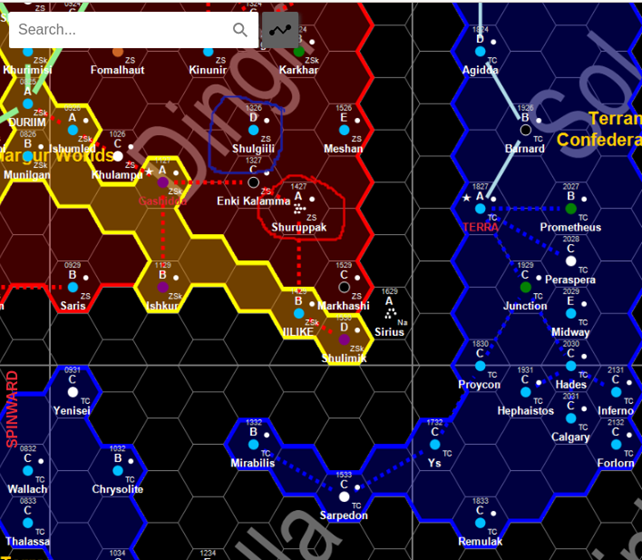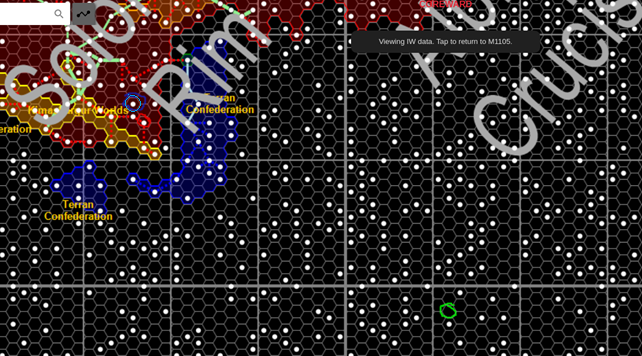Porting GURPS Traveller Jump rules to Mongoose Traveller (2nd Edition)
This article originally appeared in the November/December 2021 issue.
Up until recently, my sole active involvement with Traveller of any stripe has been GMing GURPS Traveller (GT) on and off for the past 20 years.
That applecart got upset recently when, through no solicitation or effort of my own, my current group asked me to run Mongoose Traveller 2nd edition (MGT2).
After a session, I found the MGT2 Jump rules grating, and I also wanted to give more PCs a fair and equal chance to mess Jump operations up.
Given my background, I went for the GT jump rules and shoe-horned them into MGT2.
In GT, as per GT 2nd edition p121, a successful jump requires the following three rolls to succeed:
Piloting (High Performance Starship);
Astrogation - now Navigation (Hyperspace) in GURPS 4th ed;
Mechanic (J-Drive).
Simple failure means the given step was unsuccessful, and can be retried (at -1 penalty per subsequent attempt). A critical failure (or simple failure if the crew was fatigued/rushed) means there’s a potential mishap. Reroll the roll that critically failed – any success catches the potential mishap and converts it to a simple failure, while a second critical failure results in a jump disaster. Ordinary failure on this roll lets the mishap proceed.
The mishap details are later in this article, as they are system independent.
Back to Mongoose Traveller, now.
The base difficulty for all Jump-related rolls is 4. That goes up to 5 for milieux like the Interstellar Wars, where deliberate jumps into deep space are not possible.
As per Mongoose Traveller 2e Core Rulebook, approx p148, the following DMs apply to all Jump-related rolls:
Jump drive not maintained: -1 DM per month unmaintained.
Using unrefined fuel when drives not capable of handling it: -2 DM
Jumping within 100 diameters: -4 DM
The following also apply to all Jump-related rolls, mostly ported from GURPS Traveller.
Jumping within 10 diameters: -4 DM, stacks with within-100D penalty.
Distance being jumped: -1 DM per parsec jumped. (Not ported - Mongoose only applied this to the astrogation check).
If a roll fails but not critically (namely, not snake eyes or Effect of -6 or worse), the operator can retry at a cumulative -1 per failed attempt, or the entire Jump attempt must be aborted. Retry penalties are independent between different skills. The Pilot check having to be retried three times doesn’t penalise the Engineer (J-Drive) roll.
If a roll critically fails (snake eyes or Effect of -6 or worse), a trained operator (having 0 or better in the skill, rather than defaulting – relying on any level of Jack-of-All-Trades in lieu of actual skill also counts as defaulting) can roll again, at same difficulty, DM, etc, to catch the potential mishap and convert it to a simple failure on success. Critically failing this second roll converts the mishap to disaster.
The trained-only ability to catch pending mishaps is an attempt to reduce the sheer scope and flexibility of the Jack-of-All-Trades skill.
The following rolls need to be made in the following order to successfully enter Jump:
Astrogation (1D×10 min, EDU).
A successful (or uncaught-mishap/disaster) Astrogation roll sets up two parallel task chains:
Pilot (spacecraft or capital ship) (1D×10 min, DEX).
Engineer (J-drive) (1D×10 min, EDU).
An ordinary jump, as per Mongoose rules, takes 140 + 6D6 hours.
If any roll results in jump disaster, apply that first – the jumping ship is destroyed or severely damaged.
If an uncaught mishap occurs, the details depend on where the mishap occurred:
Astrogation: Roll 1d6
1: The ship has exited near a solitary world, comet, or odd chunk of rock in the origin star system.
2-3: The ship exits near a world or gas giant in the destination star system, but not the right world or gas giant.
4-6: The ship exits at a random point on the destination star’s 100-diameter limit.
Pilot: No jump – jump drive will not engage, fuel is not consumed. The ship must make a fresh Jump attempt.
Engineer (J-drive): Roll 1d6:
1-2: Ship does not jump (as per Pilot mishap).
3-4: Failed jump – the ship appears to enter jump normally, spends approximately a week in jumpspace, and then reverts to normal space at the exact point it entered Jump.
5-6: Misdirected jump – Ship emerges from jump at a point potentially very distant from its destination.
At the GM’s option, failing the Engineer catch-mishap roll by at least 2 can increase the time elapsed in Jump by 1D6 days.
Until emergence from jump (or going past 8 days), an astrogation mishap, a failed jump and a misdirected jump cannot be distinguished.
| Misdirected Jump Table (from GURPS Traveller 2nd edition, p120) | ||
|---|---|---|
| Roll | Direction | Distance (pc) |
| 2 | 0 deg | 1d6÷2 |
| 3 | 30 deg starboard | 1d6 |
| 4 | 30 deg port | 1d6 |
| 5 | 30 deg starboard | 2d6 |
| 6 | 30 deg port | 2d6 |
| 7 | 60 deg starboard | 3d6 |
| 8 | 180 deg | 3d6 |
| 9 | 60 deg port | 4d6 |
| 10 | 60 deg port | 3d6 |
| 11 | 30 deg starboard | 5d6 |
| 12 | 60 deg starboard | 5d6 |
|
Roll 2d6 twice, once for direction, once for distance |
||
Worked mishap example:
The 200 dton MV Butcher’s Paradise is jumping outbound from Shulgiili (Solomani Rim 1326, circled in blue) en route to Shuruppak (Solomani Rim 1427, circled in red) in the dying decades of the Ziru Sirka (2125 AD, to be precise). Her captain, Drake Milford, astrogates, while we have Rosa Keeper at the helm and Nikki Thornton down in Engineering. (See map, right)
First, the base Jump difficulty will be 5, not 4, because this is the Interstellar Wars milieu. The Jump drive is in good nick, fuel is clean, and the intended jump is two parsecs, imposing a -2 DM on all rolls.
First up, astrogation à la Milford. His EDU mod is +1, and his Astrogation skill is 1, which offsets the distance-based DM, requiring his player to roll 5 or better on 2d6. The player succeeds by 2, which gives a +1 to each of the following two rolls.
Second, a Pilot roll to properly insert into the Jump course properly. Rosa’s DEX mod is +1, her Pilot (spacecraft) skill is +1, and she gets a +1 bonus from the captain. The first two of those offset the distance-based DM, requiring her player to roll 4 or better on 2d6. Rosa’s player rolls 11, succeeding handily.
Finally, the Engineer (J-Drive) roll to actually get underway. Nikki’s EDU mod is +1, her Engineer (J-Drive) skill is +2, and she also gets the +1 bonus from the captain. All up, she needs to roll 3 or better on 2d6.
Nikki rolls snake-eyes – a natural 2. There is a potential mishap – she rolls again and gets 9 on 2d6, converting the potential mishap to a simple failure.
Electing to try again rather than waste the astrogation and piloting effort (and brass off the captain), Nikki now needs 4 or better on 2d6. She manages another snake-eyes as the other players start giggling.
Now to see if she can catch the mishap – 3 on 2d6, a normal failure, is not the way to do it. The other players split their sides laughing.
No disaster (that would need the catch-mishap roll to also critically fail), but the crew faces an Engineer (J-drive) mishap. The GM rolls a 5, indicating a misdirected jump.
The laughter stops abruptly, much like Wile E. Coyote running into a wall.
The GM rolls 2d6 twice, rolling 6 and 12, respectively.
The first roll, reading off the middle column of the Misdirected Jump table, results in “30 degrees port” – the direction of the misjump is 30 degrees counter-clockwise on a hex map from the intended jump direction. In this case, the intended Jump direction was 5 o’clock, and the misjump is 4 o’clock.
The second roll means the misjump is 5d6 parsecs long. Giggling madly, the GM rolls a total of 27, but doesn’t tell the players yet. On the map (right), the origin hex (Shulgiili) is circled in red, the intended destination (Shuruppak) is circled in blue, and the actual destination (Neworld 1002) is circled in green. Once informed of their actual destination, the players proceed to name the misjump “The Goofy Holler”.
 Freelance
Traveller
Freelance
Traveller
